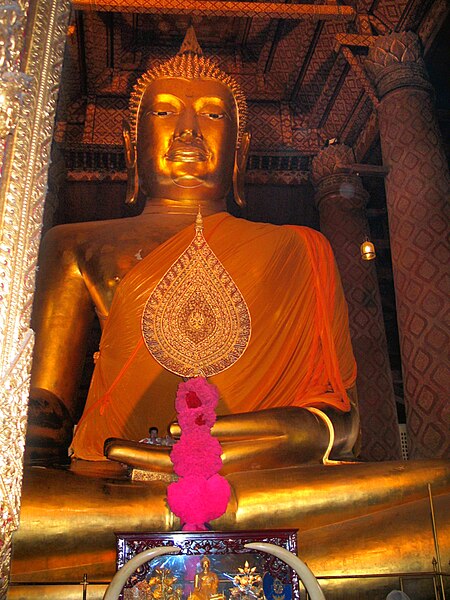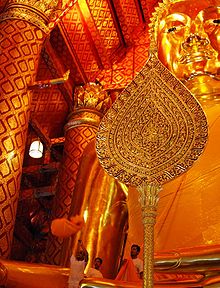Wat Phanan Choeng (Thai: วัดพนัญเชิง) is located in the southeastern area at the confluence of the Chao Phraya and the Pa Sak Rivers, one of the most vibrant and oldest temples in Ayutthaya. This monastery has no record as to its date of construction or the person initiating its construction. It existed before Ayutthaya was founded as the capital.
Following the Luang Prasoet version of the Royal Chronicles of Ayutthaya, Phra Phanan Choeng was built in 1324, 26 years before King U-Thong founded Ayutthaya. At origin the Buddha image stood in the open.
 The Buddha image - made of brick and mortar and covered with stucco - sits in the classic posture of Subduing Mara. It measures (approx.) 14 meters at the lap and 19 meters in height including the ornament above the head. Thai people call it “Luang Phor To” or “Great Reverend Father”, Chinese or Thais of Chinese origin call it “Sam Po Kong”. It is one of the largest, oldest, beautiful and revered Buddha images of Thailand.
The Buddha image - made of brick and mortar and covered with stucco - sits in the classic posture of Subduing Mara. It measures (approx.) 14 meters at the lap and 19 meters in height including the ornament above the head. Thai people call it “Luang Phor To” or “Great Reverend Father”, Chinese or Thais of Chinese origin call it “Sam Po Kong”. It is one of the largest, oldest, beautiful and revered Buddha images of Thailand.When the Burmese took Ayutthaya in 1767, though an old temple, Wat Phanan Choeng has never been deserted by its followers. Continuous development has been made through time, as evidenced by the existing landscape and Thai architectural structures decorated by art motifs from different periods.
The monastery has four principal buildings in its sangkha area: an ordination hall, a vihara, the large vihara and a small Chinese building.
 The ordination hall contains three Buddha images all in the posture of subduing Mara. Two images are assumed to have been built during the Sukhothai period around 1357. They were covered with stucco, lacquered and gilt, probably to hide their value from the Burmese invaders in 1767. In 1963 during a cleaning process, the stucco came off and the metal became visible. One image is in gold measuring a width of 145 cm and a height of 190 cm. The second one is made from an alloy of copper, silver and gold and measures at width 170 cm and at height is 228 cm. The third image in the middle of the pedestal is an Ayutthaya stucco image covered with gold (width 182 cm - height is 256 cm). The ubosot has beautiful mural paintings although from recent times.
The ordination hall contains three Buddha images all in the posture of subduing Mara. Two images are assumed to have been built during the Sukhothai period around 1357. They were covered with stucco, lacquered and gilt, probably to hide their value from the Burmese invaders in 1767. In 1963 during a cleaning process, the stucco came off and the metal became visible. One image is in gold measuring a width of 145 cm and a height of 190 cm. The second one is made from an alloy of copper, silver and gold and measures at width 170 cm and at height is 228 cm. The third image in the middle of the pedestal is an Ayutthaya stucco image covered with gold (width 182 cm - height is 256 cm). The ubosot has beautiful mural paintings although from recent times.The vihara located parallel and to the north side of the ordination hall has a Buddha image in the subduing Mara posture and also very nice Chinese mural paintings.
 The large vihara behind the buildings above houses Luang Phor To. The large wooden entry doors are carved with beautiful floral designs, while the middle of the panels are decorated with deities and mythical animals, all in traditional Ayutthaya art. Inside the walls have hundreds of niches, each containing Buddha images and suggesting the principal image sitting in the middle of the Buddhist universe.
The large vihara behind the buildings above houses Luang Phor To. The large wooden entry doors are carved with beautiful floral designs, while the middle of the panels are decorated with deities and mythical animals, all in traditional Ayutthaya art. Inside the walls have hundreds of niches, each containing Buddha images and suggesting the principal image sitting in the middle of the Buddhist universe.The large Buddha image has been repaired many times during Ayutthaya’s period of rule. King Mongkut (Rama IV) ordered a restoration in 1854 and named the statue Phra Buddha Trai Rattana Nayok. The temple and the Buddha image were damaged by fire on 21 December 1901. King Chulalongkorn (Rama V) ordered its restoration, what was finished the year after. The cheeks and the lower jaws of the image broke in pieces on 15 March 1928. In 1929 the Royal Institute had the necessary reparations made.
Source: http://www.ayutthaya-history.com
Images: http://commons.wikimedia.org/wiki/Category:Wat_Phanan_Choeng
Images: http://commons.wikimedia.org/wiki/Category:Wat_Phanan_Choeng










0 comments:
Post a Comment